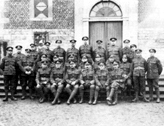A Peaceful Man
Francis Pegahmagabow was one of the most highly decorated Indigenous soldiers of the First World War.26 An Ojibwa from the Parry Island Band in Ontario, he was awarded the Military Medal (MM) plus two bars for bravery in Belgium and France.27 Soldiers who had been awarded the MM and later performed similarly heroic acts could receive bars to it, denoting further awards. Pegahmagabow was one of 39 members of the CEF who received two bars to the MM.

Cpl. Francis Pegahmagabow of the Parry Island Band in Ontario was decorated three times for the marksmanship and scouting skills he displayed in Belgium and France. Known as 'Peggy' to other members of his battalion, he survived the war and later became chief of his band. This portrait of him by artist Irma Coucill was commissioned for the Indian Hall of Fame collection, housed in the museum of the Woodland Cultural Centre in Brantford, Ontario. (Woodland Cultural Centre)
Pegahmagabow enlisted with the 23rd Regiment (Northern Pioneers) in August 1914, almost immediately after war was declared. Previously, he had worked along the Great Lakes as a marine fireman for the Department of Marine and Fisheries. Within weeks of volunteering, he became one of the original members of the 1st Canadian Infantry Battalion, which, along with the rest of the 20,000-strong 1st Canadian Division, landed in France in February 1915.
Sniping was the specialty of the man his fellow soldiers called "Peggy." It has been written of him, "His iron nerves, patience and superb marksmanship helped make him an outstanding sniper."28 In addition, Pegahmagabow developed a reputation as a superior scout.
The 1st Battalion experienced heavy action almost as soon as it arrived on the battlefield. It fought at Ypres, where the enemy introduced a new deadly weapon, poison gas, and on the Somme, where Pegahmagabow was shot in the leg. He recovered and made it back in time to return with his unit to Belgium.
It was during his first year on the Western Front that he became one of the first Canadians to be awarded the MM. The commendation reads:
“For continuous service as a messenger from February 14th 1915 to February 1916. He carried messages with great bravery and success during the whole of the actions at Ypres, Festubert and Givenchy. In all his work he has consistently shown a disregard for danger and his faithfulness to duty is highly commendable.”
In November 1917, the 1st Battalion joined the assault near the village of Passchendaele. Here, roughly 20,000 Allied soldiers crawled from shell crater to shell crater, through water and mud. With two British divisions, the Canadian Corps attacked and took the village, holding it for five days, until reinforcements arrived. The Allies suffered 16,000 casualties at Passchendaele, and Corporal Pegahmagabow earned his first bar to the MM.

Pegahmagabow served overseas for almost the entire war and remained in Europe an additional five months after the Armistice. Back home, he would join the militia. Here Pegahmagabow’s fellow non-commissioned officers of the 1st Battalion pose two months after the end of the war (he is not in the picture because he was in England receiving medical treatment at the time). (Department of National Defence / Library and Archives Canada / PA-3831)
His citation reads: At Passchendaele Nov. 6th/7th, 1917, this NCO [non-commissioned officer] did excellent work. Before and after the attack he kept in touch with the flanks, advising the units he had seen, this information proving the success of the attack and saving valuable time in consolidating. He also guided the relief to its proper place after it had become mixed up.29
Pegahmagabow would earn his second bar to the MM during the final months of the First World War in the Battle of the Scarpe (part of the 2nd Battle of Arras). The commendation reads:
"During the operations of August 30, 1918, at Orix Trench, near Upton Wood, when his company were almost out of ammunition and in danger of being surrounded, this NCO went over the top under heavy MG [machine gun] and rifle fire and brought back sufficient ammunition to enable the post to carry on and assist in repulsing heavy enemy counter-attacks."30
In April 1919, Pegahmagabow was invalided to Canada, having served for nearly the entire war. Afterward, he joined the Algonquin Regiment in the non-permanent active militia and, following in the steps of his father and grandfather, became chief of the Parry Island Band and later a councillor. A member of Canada's Indian Hall of Fame,31 Pegahmagabow died on the reserve in 1952.
Francis Pegahmagabow rarely spoke of his military accomplishments. However, his son Duncan recalls being told that his father was responsible for capturing 300 enemy soldiers. "My mother [Eva] told me he used to go behind enemy lines, rub shoulders with the enemy forces and never get caught."32 Duncan also remembers that Pegahmagabow "felt very strongly about his country." Mostly, he sees his father as a peaceful man: "He was always saying how we have to live in harmony with all living things in this world."
- Date modified: